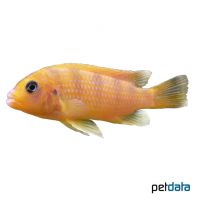Kenyi Cichlid (Metriaclima lombardoi)
| Kenyi Cichlid Metriaclima lombardoi | |
|---|---|
| Name | Kenyi Cichlid |
| Name Lat. | Metriaclima lombardoi |
| Synonym | Maylandia lombardoi |
| Family | Cichlids |
| Family lat. | Cichlidae |
| Order | Cichlids |
| Order lat. | Cichliformes |
| Origin | Lake Malawi |
| Habitat | Rocky habitat |
| Diet | Planktivore, Aufwuchs |
| pH | 7.5-8.8 |
| Behavior | Aggressive |
| Keeping | Harem |
| Care Level | Moderate |
| Reproduction | Mouthbrooder |
| Breeding | Simple |
| Life Span | 5-8 years |
| Protection | No |
| Metric Units | |
| Size | 9-12 cm |
| Temperature | 24-28 °C |
| Hardness | 10-25 °dH |
| Aquarium | ~ 300 l |
| US Units | |
| Size | 3.5"-4.7" |
| Temperature | 75-82 °F |
| Hardness | 178-445 ppm |
| Aquarium | ~ 80 gal |
Distribution and habitat
The range of the Lombardoi Malawi Cichlids is exclusively (endemically) Lake Malawi. They have produced two site variants, one at Mbenji Island and one at Nkhomo Reef. They belong to the Mbuna group, which lives in the rocky shore zones.
Maintenance
The aquarium setup should have rocky structures that reach the water surface, with plenty of crevices, caves and shelters to provide hiding places, as well as sturdy plants and some open sandy areas
There should be no detectable ammonia, ammonium or nitrite, and the nitrate level should not exceed 100 mg/l. To ensure the water quality and oxygen content, a filter and heater adapted to the aquarium size is required, as well as lighting for the species-appropriate day-night rhythm of the animals.
Diet
They feed mainly on plankton as well as on the plant cover (growth) and the microorganisms contained therein. The food supply consists of live, frozen and dry food. For a balanced diet, feed once daily with a high quality dry food for Malawi cichlids (flakes, granules, pellets) as well as cyclops, daphnia, artemia and plankton (live or frozen). In addition, they also need plant food, such as algae leaves, scalded leafy and wild vegetables or high-quality dry food with plant components (kelp, spirulina)
Only feed as much as will be eaten within a few minutes. A regular and varied diet promotes health and increases resistance.
Behaviour and compatibility
Males occupy territories which they defend vigorously against conspecifics, they are not very aggressive towards other fish. They should be kept in a harem, one male with several females. Keeping several harems is only recommended in a larger and richly structured tank. They can be socialized well with other cichlids from Lake Malawi, especially from the Mbuna group. Basically, only compatible fish species with similar demands on water condition and water temperature should be socialized.
Sex dimorphism
The male is yellowish in color and has yellow egg spots on the anal fin, which are weaker or absent in the female. The female is sky blue
Reproduction and breeding
They are maternal mouth brooders. The female usually spawns on a flat rock. After the male fertilizes the eggs, she immediately takes the female into her throat pouch for mouth brood care and keeps the fry in her throat pouch even after they hatch. After about 4 weeks, the fry are released and brood care ends. During the entire brood care, the female does not take any food.
Fry must be fed several times a day with special rearing food (Artemia nauplii). In community tanks breeding is hardly possible, because the fry is easy prey.
Important
Different site varieties of Lombardoi Malawi cichlids should not be kept together, as they may interbreed
The well-being of the fish should be monitored regularly. Temperature should be checked daily, pH, hardness and nitrate levels should be checked at least every 14 days. Regular partial water changes are recommended, even when contaminant levels have not yet reached the upper limit. Sudden changes in water quality should be avoided. Newly introduced fish must be accustomed slowly to the water in the aquarium.
Further literature can be found in your pet store.
References
Text: Sylvia Hos; Image: petdata
Source: BMELV (1998): Tierschutzgutachten - Haltung von Zierfischen (Süßwasser); BAENSCH & RIEHL (2004): Aquarien Atlas Bd. 2, Mergus Verlag; ENGELMANN (2005): Zootierhaltung - Tiere in menschlicher Obhut: Fische, Verlag Harri Deutsch
- Gemäß § 21 Abs. 5 Tierschutzgesetz idgF
